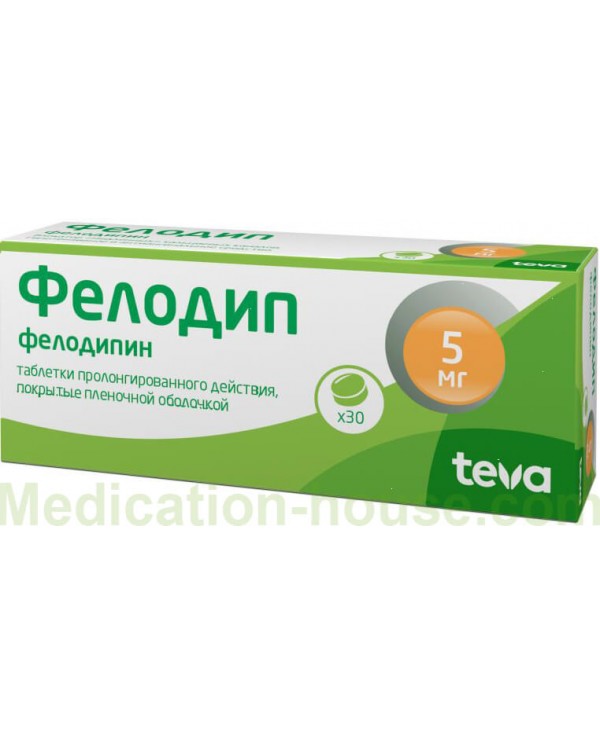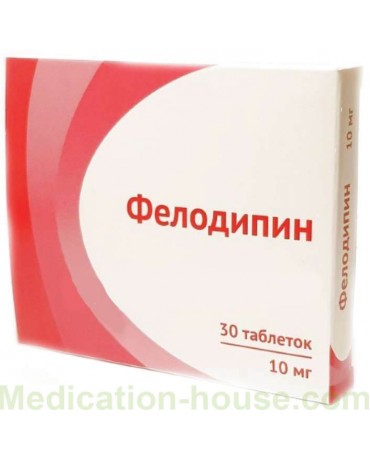Instruction for Felodip
Reed more and buy Felodip on this page
Felodip is a slow calcium channel blocker.
Release form and composition
Felodip is produced in the form of tablets of prolonged action, film-coated: round, biconvex, odorless, engraved on one side: "2.5" - for yellow tablets, "5" - light pink, "10" - reddish brown; the core is almost white or white (10 pcs. in blisters, in a cardboard box 3 or 10 blisters).
1 tablet contains:
active substance: felodipine - 2.5 mg, 5 mg or 10 mg;
auxiliary components: colloidal silicon dioxide, lactose monohydrate, povidone (type K-25), hypromellose (Methocel E50LV), propyl gallate, magnesium stearate, microcrystalline cellulose: type Avicel PH101 and type Emcocel 90M;
composition of the film shell: propylene glycol, hypromellose (type Pharmacoat 606), titanium dioxide (E171), talc, iron dye yellow oxide (E172); additionally, as part of the coating of tablets of 5 mg and 10 mg - iron oxide red dye (E172).
Pharmacodynamics
Felodip is a slow calcium channel blocker that has antihypertensive and antianginal effects.
The active substance, felodipine, is a dihydropyridine derivative. Its antihypertensive effect is due to a decrease in the total peripheral vascular resistance. Felodipine has a dose-dependent anti-ischemic effect. Reduces the size of myocardial infarction, helps to protect against complications of reperfusion.
Having a minimal effect on the conducting system, it has almost no negative inotropic effect.
Pharmacokinetics
After taking the tablet inside, almost complete absorption of felodipine from the gastrointestinal tract occurs. The delayed release of the active substance helps to lengthen the absorption period and ensure a uniform content of felodipine in the blood plasma within 24 hours. In the range of therapeutic doses, the bioavailability of the drug is about 15%.
Plasma proteins (mainly albumin) bind about 99% of the dose taken.
Felodipine crosses the placental and blood-brain barriers, is excreted in breast milk.
Long-term use of tablets does not cause cumulation.
As a result of almost complete metabolism in the liver, inactive metabolites are formed.
T1 / 2 (half-life) is 25 hours.
About 70% of the dose taken is excreted through the kidneys in the form of metabolites, unchanged - less than 0.5%. The rest is excreted through the intestines.
With impaired liver function and in elderly patients, the level of felodipine concentration in blood plasma increases.
In case of impaired renal function, including hemodialysis, the pharmacokinetic parameters of felodipine do not change.
Indications for use
arterial hypertension;
stable angina, including Prinzmetal's angina.
Contraindications
severe arterial hypotension;
myocardial infarction - an acute period and then during the first 30 days of the rehabilitation period;
clinically significant aortic stenosis;
cardiogenic shock;
heart failure in the stage of decompensation;
unstable angina;
lactose intolerance, glucose-galactose malabsorption syndrome, lactase deficiency;
period of pregnancy;
breast-feeding;
age under 18;
hypersensitivity to dihydropyridine derivatives and other components of the drug.
Caution should be exercised when prescribing Felodip in combination with beta-blockers, diuretics or angiotensin-converting enzyme (ACE) inhibitors, in patients with renal and / or hepatic insufficiency.
Instructions for use: method and dosage
Felodip tablets are taken orally, swallowing whole (without violating the integrity of the film shell) and drinking plenty of water. The procedure is carried out once a day, in the morning before a light breakfast or immediately after it.
The dose is set by the method of individual selection, using 2.5 mg tablets, including for elderly patients.
Recommended dosage of Felodip:
arterial hypertension: the initial dose is 5 mg, for patients in old age or with impaired liver function - 2.5 mg. To achieve the desired therapeutic effect, the initial dose can be gradually increased. Maintenance therapy is usually 5 mg or 10 mg;
stable angina pectoris: the initial dose is 5 mg. If necessary, it is increased to 10 mg. The maximum daily dose is 20 mg.
For patients with severely impaired liver function, the dose of Felodip for maintenance therapy should be reduced.
Side effects
on the part of the cardiovascular system: very often - peripheral edema; often - flushing of the face; rarely - tachycardia, palpitations;
from the immune system: rarely - allergic reactions in the form of urticaria; very rarely - hypersensitivity reactions, angioedema;
from the nervous system: often - headache; infrequently - paresthesia, dizziness; rarely - fainting;
from the digestive system: infrequently - abdominal pain, nausea; rarely - vomiting; very rarely - gingivitis, gingival hyperplasia, increased activity of hepatic transaminases;
from the urinary system: very rarely - pollakiuria;
from the musculoskeletal system: rarely - myalgia, arthralgia;
dermatological reactions: infrequently - itching, rash; very rarely - photosensitivity, leukocytoclastic vasculitis;
others: infrequently - fatigue; rarely - sexual dysfunction.
Overdose
Symptoms: excessive lowering of blood pressure (BP), bradycardia.
Treatment: symptomatic therapy, with a significant decrease in blood pressure, the patient should immediately take a horizontal position, the head of the bed should be low. To stop bradycardia, intravenous administration of 0.5–1 mg of atropine is indicated. If it is necessary to increase the volume of circulating blood, the patient is prescribed an infusion of a solution of dextrose (glucose), dextran or sodium chloride. In the absence of the desired effect, the use of drugs acting mainly on alpha-adrenergic receptors is indicated.
Special instructions
In rare cases, Felodip can cause significant arterial hypotension and the development of myocardial ischemia in predisposed patients.
The expediency of prescribing the drug for secondary prevention of myocardial infarction has not been established.
When Felodip is prescribed in combination with ACE inhibitors, beta-blockers or diuretics, an increase in the antihypertensive effect and an increased risk of arterial hypotension should be taken into account.
Against the background of the use of the drug, the most frequently occurring undesirable phenomena include: redness of the skin of the face, palpitations, headache, dizziness, increased fatigue. They usually appear at the beginning of treatment or when the dose of Felodip is increased and are reversible. Inadequate doses can cause precapillary vasodilation and peripheral edema.
With gum disease or periodontitis, the risk of developing mild gum swelling increases, so it is recommended that the use of tablets be accompanied by careful oral hygiene.
The use of Felodip has a therapeutic effect and demonstrates good tolerance in patients of both sexes at any age, with impaired renal function, lung diseases (including bronchial asthma), diabetes mellitus, hyperlipidemia, gout, Raynaud's syndrome, in patients after lung transplantation.
Felodipine does not affect the level of glucose concentration in blood plasma, on the lipid profile.
Influence on the ability to drive vehicles and complex mechanisms
If weakness or dizziness is observed while taking Felodip, patients should refuse to perform all potentially hazardous activities that require concentration of attention and a high speed of psychomotor reactions, including driving.
Application during pregnancy and lactation
According to the instructions, Felodip is contraindicated for use during gestation and during breastfeeding.
Childhood use
Patients under the age of 18 are contraindicated in the appointment of Felodip due to the lack of information on the safety and efficacy of its use.
With impaired renal function
It is recommended to use Felodip with caution in case of renal failure.
For violations of liver function
Felodip should be used with caution in liver failure. In case of impaired liver function, the initial daily dose should be 2.5 mg, in case of severe impairment, it should be reduced.
Use in the elderly
The initial daily dose for elderly patients should be 2.5 mg.
Drug interactions
With the simultaneous use of Felodip:
digoxin: increases its plasma concentration, but the level of increase does not require a change in the dosage regimen of the drug;
verapamil, beta-blockers, tricyclic antidepressants, diuretics: enhance the hypotensive effect of felodipine;
cimetidine, erythromycin, itraconazole, ketoconazole and other inhibitors of cytochrome P450: slow down the metabolism of felodipine in the liver and increase its concentration in blood plasma;
non-steroidal anti-inflammatory drugs: do not affect the antihypertensive effect of the drug;
tacrolimus: may increase its plasma concentration to a level that requires dose adjustment;
grapefruit juice: increases the bioavailability of felodipine, so their combination is recommended to be avoided.
Felodipine has a high degree of binding to plasma proteins, but this does not affect the binding of free fractions of other drugs, including warfarin.
Terms and conditions of storage
Keep out of the reach of children.
Store at a temperature of 10-25 ° C in a dark place.
Shelf life is 4 years.
Reviews
Reviews about Felodip are only positive, they indicate the high efficacy of the drug, both in the treatment of arterial hypertension and stable angina pectoris. Patients note the good tolerance of the drug, the absence of addiction. Long-term use in patients with angina pectoris leads to a significant decrease in the frequency of anginal pain, the degree of their severity, which has a positive effect on the general well-being of patients.
Terms of sell
You don't need a prescription to buy Felodip.


